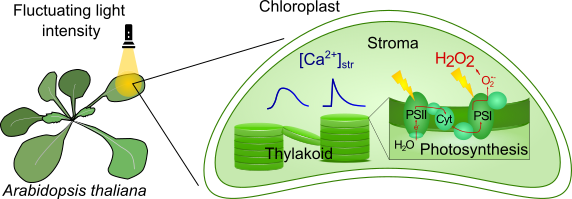Contact
Simon Stael, Associate senior lecturer
Light intensity is rarely stable during the span of a day – think of changing cloud cover, shading, flickering of leaves and daily rhythms of dusk and dawn. As the primary site of photosynthesis, chloroplasts house the reactions for conversion of sunlight to chemical energy for most food, feed, and fuel in the world. Furthermore, chloroplasts are powerhouses of metabolism and can produce many of the initial products for plant hormones and secondary defense metabolites. How does photosynthesis and metabolism cope with an ever-changing energy supply caused by the input of fluctuating light intensity? Next to being an important macronutrient, fluctuating concentrations of calcium ions (Ca2+) can transduce information from the environment to the cell. So-called calcium signatures are created by patterns of locally elevated Ca2+ concentrations in response to particular stresses and can signal the perturbed cellular homeostasis through changes in protein conformation or protein-lipid interaction. The chloroplast can manage its own Ca2+-dynamics and storage capacity. We investigate the link between chloroplast calcium signaling and response to light intensity and how that may affect photosynthesis and plant metabolism.

Alex Costa, University of Milan, https://www.unimi.it/en/ugov/person/alex-costa
Markus Schwarzländer, University of Münster, https://www.uni-muenster.de/Biologie.IBBP/agschwarzlaender/en/arbeitsgruppe/markus_schwarzlaender.html
Lorella Navazio, University of Padova, https://www.unipd.it/en/contatti/rubrica/?ruolo=1&checkout=cerca&persona=NAVAZIO&key=36F37DD1745240F01DA5E2CA219972C8
Bernhard Wurzinger, BOKU University, https://boku.ac.at/en/personen/person/56E40FA8866B6C55
Markus Teige, University of Vienna, https://mosys.univie.ac.at/team/markus-teige/
Marc Knight, Durham University, https://www.durham.ac.uk/staff/m-r-knight/
Steffen Vanneste, Ghent University, https://research.ugent.be/web/person/steffen-vanneste-0/en
Daniel Van Damme, VIB-UGent Center for Plant Systems Biology, https://www.psb.ugent.be/index.php/people/VanDammeDaniel
Simon Stael, Associate senior lecturer